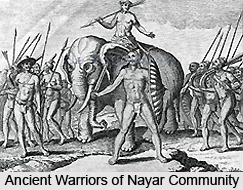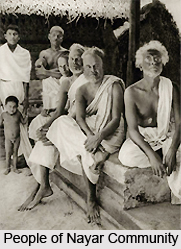 Nayar community, also known as Nair community, belongs to the Hindu caste in the state of Kerala. Traditionally a martial people, the Nayars have made history in Kerala. Today they are more distinguished as bureaucrats, writers, artists, administrators and diplomats. They are the community in the country that has a matriarchal form of society. Under the marumakkathayam system, the property rights of the joint family are vested in the female members and are passed on from mother to daughter. However, the property is managed by the oldest male relative of the family, who is called the karanavan.
Nayar community, also known as Nair community, belongs to the Hindu caste in the state of Kerala. Traditionally a martial people, the Nayars have made history in Kerala. Today they are more distinguished as bureaucrats, writers, artists, administrators and diplomats. They are the community in the country that has a matriarchal form of society. Under the marumakkathayam system, the property rights of the joint family are vested in the female members and are passed on from mother to daughter. However, the property is managed by the oldest male relative of the family, who is called the karanavan.
History of Nayar Community
The Brahmins arrived in Kerela in about the first millennium. This ruling class was Nayars who already had an established kingdom there. Before the advent of British rule, the region had small feudal kingdoms and in each of them the Nayars constituted the royal and noble lineages, the militia and the land managers. During the rule of British, the people belonging to this community gained prominence in law, education, medicine, government service and politics. They have their own marital arrangements, laws of succession, discipline and involvement in the arts and culture, such as, Kathakali. They were a class of professional warriors with a high skill in swordsmanship who formed themselves into suicide squads called chavers, in wartimes. As warriors the Nayars were unequalled and their sense of loyalty was legendary. Nayar community despised manual work and left the ploughing and tilling to tenants or hired hands. Attached to the house of each village headman was a kalari in which young men trained in the art of combat and defence. Till date it is a famous martial art form in Kerela.
Demography of Nayar Community
 Nayars are essentially Dravidians. Many have a lighter complexion than the Tamil Dravidians and resemble North Indians in their facial structure which may be the result of interbreeding with the Namboodiri Brahmins.
Nayars are essentially Dravidians. Many have a lighter complexion than the Tamil Dravidians and resemble North Indians in their facial structure which may be the result of interbreeding with the Namboodiri Brahmins.
Sub Castes of Nayar Community
Nayar community has many sub castes, the majority being land owners. Several subgroups have been made primarily according to the occupation, which include barbers, potters, servants, palanquin bearers, coppersmiths, traders, drummers etc. Ethnologists, anthropologists and authors however believe that the last name of a Nayar is the title which indicates the subgroup of a person along with the occupation pursued by him or bestowed on him by a chief or king. Classification of this community has undergone many variations. However presently Nayars are not treated as a single entity by the government. Illathu and Swaroopathu Nairs are considered as a forward caste while the Veluthedathu, Vilakkithala and Andhra Nairs are grouped as other backward classes.
Religion of Nayar Community
Religion of the Nayars reflects an amalgamation of many religions. While they celebrate spring festivals similar to those of the Hindus there are certain religious rites that establish their proximity with the Scythians or Nagas.
Society of Nayar Community
Society of Nayar community is one of those societies that provide financial security to the women. According to them women provide the foundation stone of a particular community. Hence a girl child is preferred to a male child. These people are mostly concentrated in Kerela and are known for their contribution to art and culture. Nayars are essentially non-Aryan in their customs, manners, social structure and family set up. Their ways of living, mores and values are also quite distinct from those of other Malayalis. Personal hygiene is not merely a way of keeping clean but a way of life for the Nayars. The daily oil bath is a compulsory and complex ritual that can take up to two hours.




















